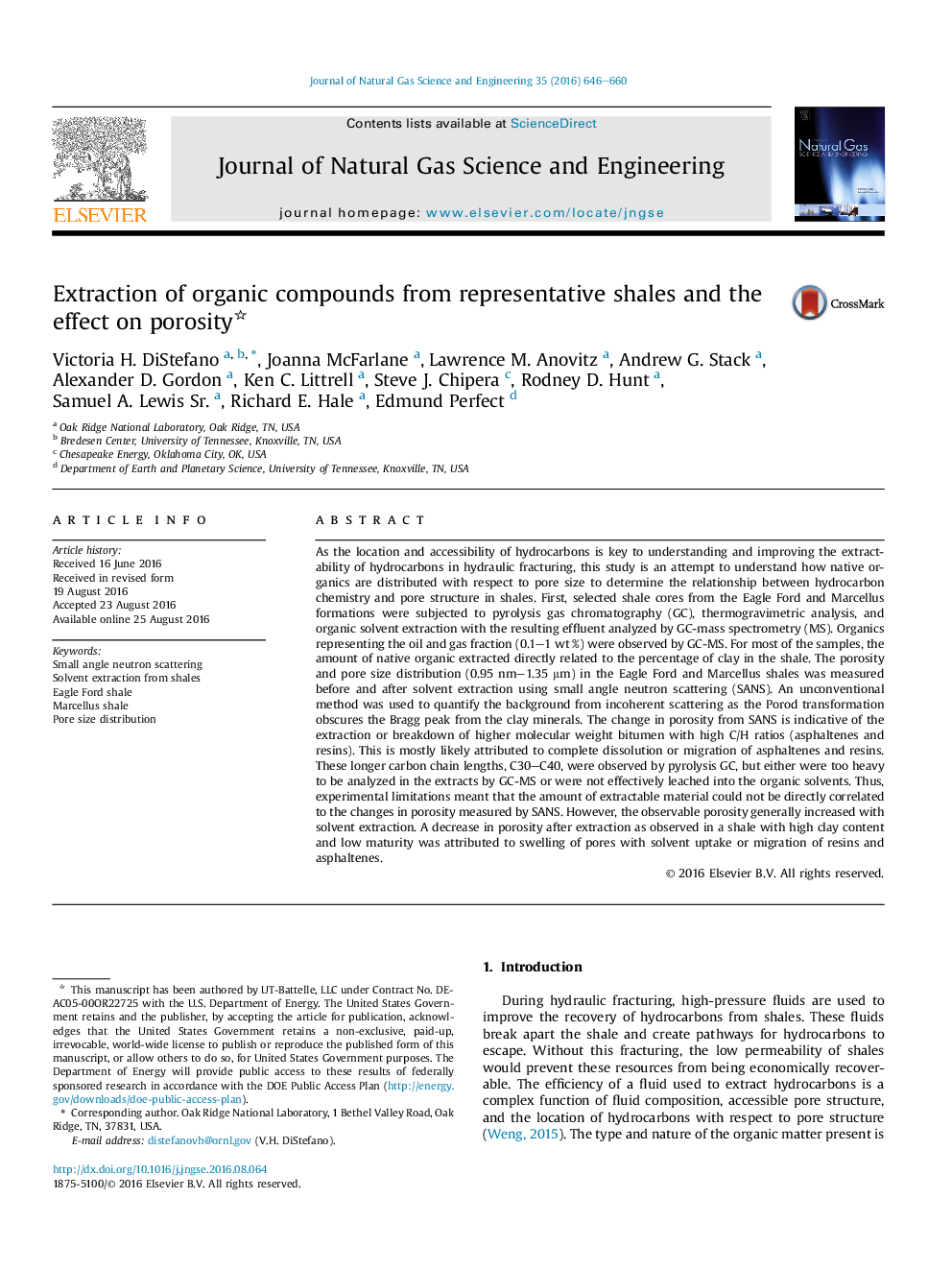| Article ID | Journal | Published Year | Pages | File Type |
|---|---|---|---|---|
| 6481575 | Journal of Natural Gas Science and Engineering | 2016 | 15 Pages |
•The relationship between native hydrocarbons in shales and shale porosity was studied.•Organic solvents were used to leach hydrocarbons from shales.•Porosity distributions were measured before and after leaching using neutron scattering.•The amount of leached organic was proportional to the clay composition.•Changes in porosity were attributed to extraction or breakdown of bitumen.
As the location and accessibility of hydrocarbons is key to understanding and improving the extractability of hydrocarbons in hydraulic fracturing, this study is an attempt to understand how native organics are distributed with respect to pore size to determine the relationship between hydrocarbon chemistry and pore structure in shales. First, selected shale cores from the Eagle Ford and Marcellus formations were subjected to pyrolysis gas chromatography (GC), thermogravimetric analysis, and organic solvent extraction with the resulting effluent analyzed by GC-mass spectrometry (MS). Organics representing the oil and gas fraction (0.1–1 wt %) were observed by GC-MS. For most of the samples, the amount of native organic extracted directly related to the percentage of clay in the shale. The porosity and pore size distribution (0.95 nm–1.35 μm) in the Eagle Ford and Marcellus shales was measured before and after solvent extraction using small angle neutron scattering (SANS). An unconventional method was used to quantify the background from incoherent scattering as the Porod transformation obscures the Bragg peak from the clay minerals. The change in porosity from SANS is indicative of the extraction or breakdown of higher molecular weight bitumen with high C/H ratios (asphaltenes and resins). This is mostly likely attributed to complete dissolution or migration of asphaltenes and resins. These longer carbon chain lengths, C30–C40, were observed by pyrolysis GC, but either were too heavy to be analyzed in the extracts by GC-MS or were not effectively leached into the organic solvents. Thus, experimental limitations meant that the amount of extractable material could not be directly correlated to the changes in porosity measured by SANS. However, the observable porosity generally increased with solvent extraction. A decrease in porosity after extraction as observed in a shale with high clay content and low maturity was attributed to swelling of pores with solvent uptake or migration of resins and asphaltenes.
Graphical abstractThis research comprises a multidisciplinary study showcasing the use of neutron scattering to understand changes in shale porosity arising from hydrocarbon extraction. The shales were analyzed using standard rock evaluation methods, and hydrocarbons were extracted by leaching with a variety of organic solvents. The pore size distribution was probed using small angle neutron scattering. Most of the shale samples came from the Eagle Ford play in Texas, but we also obtained samples from the Marcellus play in Pennsylvania. There are three possible mechanisms of porosity development due to extraction by solvents that could be observed by SANS. Porous kerogen and bitumen in the rock matrix (composed of minerals and nonporous or inaccessible porous kerogen) could (1) completely breakdown into smaller molecules that can be extracted (2) migrate into smaller pores or (3) partially dissolve leaving behind the kerogen portion. This study can serve as a demonstration of how neutron scattering, along with other methods of analysis, can be used to understand complex fluid (fuel)-rock interactions in geological samples.Figure optionsDownload full-size imageDownload high-quality image (221 K)Download as PowerPoint slide
